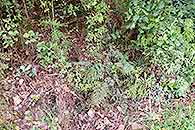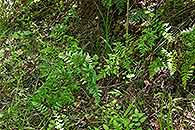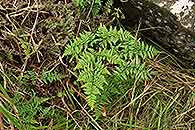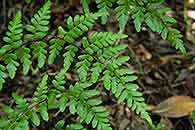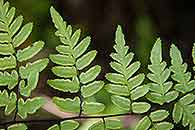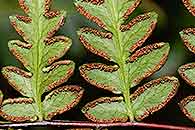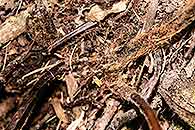Cheilanthes quadripinnata (Forssk.) Kuhn
Synonyms |
Pellaea consobrina Kunze |
|---|---|
Common name |
|
Description |
Rhizome short, creeping, 6-7 mm in diameter; rhizome scales narrowly lanceolate to linear in outline, apex slowly tapering to a point, margin (sub)entire, up to 10 mm long, some pale brown, others with black central stripe and pale margins. Fronds monomorphic, tufted, up to 120 cm tall, erect to arching, coracious. Stipe up to 45 cm long, about 1.2 times the length of the lamina, castaneous to blackish, shiny, shallowly grooved in the upper part, hairless at maturity but set with long, reddish brown hairlike, narrow scales at the base. Lamina 4-pinnatifid to 5-pinnate on the basal pinnae, triangular or pentagonal in outline, 20-60 × 14-40 cm; lower pinnae ascending, deltate, basiscopically developed, with triangular, pinnatifid apex, uppermost pinnae pinnatifid; ultimate segments oblong, rounded to pointed, both surfaces hairless, lobed and broader when sterile, narrow and (sub)entire when fertile; venation free, obscure above except for midrib; rhachis and secondary rhachis castaneous, grooved, hairless. Sori linear, marginal, continuous except for the extreme apices and sinuses; indusium continuous, entire to erose, membranous. |
Notes | May be confused with C. viridis var. viridis which is less divided (lamina 2- to 3-pinnate), has weakly developed basiscopically basal pinnae and veins that are distinct on the upper surface. |
Derivation | quadripinnata: 4-pinnate, the fronds are divided four times. |
Habitat | Around boulders and among tall grasses, rocks by streams, banks and wet bare soil by rivers, alpine meadows, scrub, forest margins, in grassland, in light shade or full sun. |
Distribution worldwide | Africa, Madagascar, Mauritius and the Comoro islands. |
Distribution in Africa |
Cameroon, Ethiopia, Kenya, Lesotho, Malawi, Mozambique, Rwanda, South Africa, Sudan and South Sudan, Swaziland, Tanzania , Uganda, Zimbabwe. |
Growth form |
Lithophytic, terrestrial. |
Literature |
|
